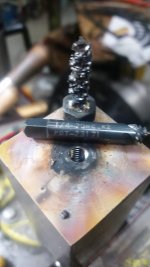NO, I don't. I never have enough.
As for the spiral flute, I did notice that. IMHO, you still need some space for chips. They are sneaky and cantankerous and can get ahead of the bloody thing. And they can pack tight in those flutes, even if they are spiral ones.
The tap broke. I know that is true because I can see TWO pieces in the photos. You can't argue with that.
It takes force to break a tap. I have never seen one break while sitting in a box or tube. (Yea, yea, I know someone will have a story, but I don't believe it.) I stand by the fact that it does take force.
At some point while it was cutting the thread, the force on this tap became large enough to break it. I reread the original post and it apparently broke when the machine reversed to withdraw it. It seems obvious that something built up the drag on the tap to the point where the force was enough to break it.
At some point you will have to back it out anyway, unless you want to include the tap as part of your project. So I see no harm in backing it up a bit or even completely out EXCEPT that it takes TIME. Is that your "wreck"? Lost time? I could understand that. Or what? Sometimes you have to go back and forth several times to loosen the packed in chips. That's when you need to back it out completely and clean the flutes (YES, even spiral ones). I do it by feel, but using a machine to tap eliminates that. But you went to full depth with no reversals. At that point the cutting edges and the outer edges of the tap probably had NO fluid on them - between them and the metal being tapped. They were in intimate contact. Probably some molecular bonding going on there. No wonder there was a lot of force involved.
Perhaps you just have to accept some broken taps if you tap by machine. That would indicate that this is a very poor way to tap.
You used a good tapping fluid! Great! But if you only run it in one direction, DOWN, then little or none of that fluid is going to be on the cutting edges after a few threads are cut. Those cutting edges will be completely DRY. Backing up allows it to flow from the flutes where it does nothing down onto those edges where it can do some good.
I think a tapping head is a much better way if you want to power tap. I have threaded holes by the hundreds that way with zero broken taps. Of course, they cost money. Or at least something with a slip clutch.
But I still think backing up is often necessary if you want to avoid broken taps. If I were using a CNC mill to tap holes, I would program in the forward two and back one turn steps instead of just hogging down to full depth in one whack. But I guess that is me. But again, I have to wonder how someone working on a multi-hundred thousand dollar part would do it if tapping a bunch of holes was the last step. Oops, 100 plus hours of machining and a $250,000 part down the drain! I bet they would be extra, EXTRA careful at that point.
You have way too much time on your hands.
 Greg
Greg Greg
Greg




